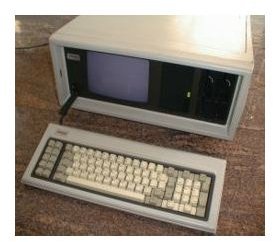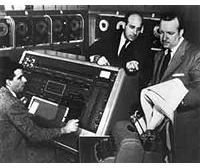This Day in Computer History: November 4
This Day in Computer History
1952
In the course of covering the U.S. presidential election, CBS News used a UNIVAC I (UNIVersal Automatic Computer) to predict the election’s outcome based on only a five percent sample of returned votes. The system projected a victory for Dwight D. Eisenhower, but CBS journalists Charles Collingwood and Walter Cronkite were so skeptical that they withheld the projections until the last minute. The astounding feat so publicly performed on the nation’s most popular news program immediately vaulted the UNIVAC into national prominence.
The United States National Security Agency is established for the purpose of collecting and analyzing foreign communications.
1982

Compaq introduced the world to the forerunner of the laptop, the Compaq Portable suitcase-sized portable computer. The twenty-eight pound system featured an Intel 8088 CPU, up to 640 KB RAM, a 5.25-inch floppy disk drive, and a full nine-inch monochrome monitor. They came equipped with either the CP/M-86 or the more popular MS-DOS operating system. Due to its immense size, the Compaq Portable would earn the nickname “the sewing machine;” however, despite its size, it would become the first successful IBM PC Clone on the market. Its success was due to its complete compatibility with the IBM PC, despite having absolutely no IBM-licensed software. Specifically, Compaq had developed a PC-compatible IBM BIOS clone for the system at the cost of a million dollars. When the computer hit shelves in January, it marked the end of IBM’s hardware monopoly and the birth of the multi-billion dollar portable PC industry. Price: US $2,995 - $3,590 (two floppy system).
1984
University of Texas undergrad Michael Dell founded PC’s Limited on only one thousand dollars of start-up capital in his off-campus dorm. His business model was to sell custom-tailored computers direct to consumers. Dell would later drop out of school to work full-time, and PC’s Limited later became Dell Inc., which, for a time, was the world’s largest computer manufacturer.
1996
Corel released the CorelDraw 7 vector graphics editor for Windows.
1999
Version 1.2.1 of the Sather programming language was released.
2004

IBM’s Blue Gene/L supercomputer at the Lawrence Livermore National Laboratory (LLNL) becomes the world’s fastest computer when it perfromed 70.72 trillion calculations per second (70.7 teraflops), overtaking NEC’s Earth Simulator, which had previously held the record of 36.01 TFLOPS.
2005
In Armonk, New York, IBM and Sun Microsystems held the “OpenDocument Summit” to discuss how to promote the adoption of the OpenDocument format (ODF) throughout the industry through existing standards bodies and to promote its usage in the marketplace. Representatives from Adobe, Computer Associates, Corel, Google, Intel, Linux, Nokia, Novell, Oracle, Red Hat, and Scalix attend the event.
This post is part of the series: A Chronology of Computer History for the Month of November: This Day in Computer History
This series provides a daily account of what happened on this day in the history of computing and technology. It discusses developments, breaking news, new releases and global implications that occurred as a result of these ground breaking events.
- This Day in Computer History: November 4
- This Day in Computer History: November 5
- This Day in Computer History: November 6
- This Day in Computer History: November 7
- This Day in Computer History: November 9
- This Day in Computer History: November 10
- This Day in Computer History: November 11
- This Day in Computer History: November 12
- This Day in Computer History: November 13
- This Day in Computer History: November 14
- This Day in Computer History: November 15
- This Day in Computer History: November 16
- This Day in Computer History: November 17
- This Day in Computer History: November 18
- This Day in Computer History: November 19
- This Day in Computer History: November 20
- This Day in Computer History: November 21
- This Day in Computer History: November 22
- This Day in Computer History: November 24
- This Day in Computer History: November 25
- This Day in Computer History: November 26
- This Day in Computer History: November 27
- This Day in Computer History: November 28
- This Day in Computer History: November 29
- This Day in Computer History: November 30
